What We’re Reading: April 13th edition
Guest Editor: Dr. Elisa Dell’Aglio
 Elisa holds a PhD in Plant Biochemistry from the University of Grenoble – CEA (France) and just finished a first Post-Doc at the University of Geneva, Switzerland. She has been a Plantae Fellow since September 2017. Her work is aimed at understanding how cofactors, such as NADP and Vitamin B6, help plants to overcome abiotic and biotic stress conditions. While away from the bench, she reads and writes about science and life as a scientist.
Elisa holds a PhD in Plant Biochemistry from the University of Grenoble – CEA (France) and just finished a first Post-Doc at the University of Geneva, Switzerland. She has been a Plantae Fellow since September 2017. Her work is aimed at understanding how cofactors, such as NADP and Vitamin B6, help plants to overcome abiotic and biotic stress conditions. While away from the bench, she reads and writes about science and life as a scientist.
Commentary: The discovery of nickel hyperaccumulation in the New Caledonian tree Pycnandra acuminata 40 years on: an introduction to a Virtual Issue (OA)
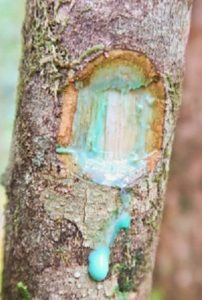 A Commentary by Jaffé et al. introduces a New Phytologist Virtual Issue on the curious and fascinating plants that hyperaccumulate metals. These diverse species have shed light on metal transporter proteins and mechanisms of metal tolerance, on the ecological function of metal hyperaccumulation (possibly to deter herbivores, pathogens, or neighboring plants), and might even provide a low-cost, environmentally-friendly way to extract metals from soil (phytomining and phytoremediation). These plants are also a great way to stimulate curiosity; who wouldn’t be captivated by a photo showing a plant “bleeding” blue latex? (Summary by Mary Williams) New Phytol. 10.1111/nph.15105
A Commentary by Jaffé et al. introduces a New Phytologist Virtual Issue on the curious and fascinating plants that hyperaccumulate metals. These diverse species have shed light on metal transporter proteins and mechanisms of metal tolerance, on the ecological function of metal hyperaccumulation (possibly to deter herbivores, pathogens, or neighboring plants), and might even provide a low-cost, environmentally-friendly way to extract metals from soil (phytomining and phytoremediation). These plants are also a great way to stimulate curiosity; who wouldn’t be captivated by a photo showing a plant “bleeding” blue latex? (Summary by Mary Williams) New Phytol. 10.1111/nph.15105
Review: The role of auxin in cell wall expansion (OA)
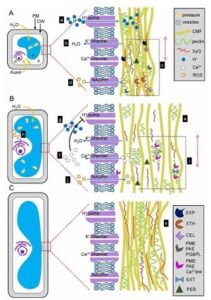 Cell wall is the outermost boundary for a cell. For the protection of cell, it maintains its rigidity. At the same time, for providing the shape of cells, it is capable of becoming flexible. This means that the cell wall has the capacity to maintain both rigidity and flexibility based on the requirement. Auxin is one of the most studied plant hormones involved in plant growth and development. Auxin has two phase of response: early and late response. Immediately after the application of auxin, it induces cell elongation by loosening the cell wall based on the “acid growth hypothesis”. This early response occurs within 10-15 minutes before the starting of traditional signaling events. The early response is mediated through the modification of cell wall. The late auxin response is the TIR1/AFB-mediated degradation of AUX/IAA repressor. Through this pathway, auxin controls the expression of cell wall related genes such as cellulose, expansin, XTH, pectin and peroxidase genes. In this review, the authors tried to cover both sides of auxin signaling for regulating cell wall expansion. (Summary by Arif Ashraf – @aribidopsis) Int. J. Mol. Sci. 10.3390/ijms19040951
Cell wall is the outermost boundary for a cell. For the protection of cell, it maintains its rigidity. At the same time, for providing the shape of cells, it is capable of becoming flexible. This means that the cell wall has the capacity to maintain both rigidity and flexibility based on the requirement. Auxin is one of the most studied plant hormones involved in plant growth and development. Auxin has two phase of response: early and late response. Immediately after the application of auxin, it induces cell elongation by loosening the cell wall based on the “acid growth hypothesis”. This early response occurs within 10-15 minutes before the starting of traditional signaling events. The early response is mediated through the modification of cell wall. The late auxin response is the TIR1/AFB-mediated degradation of AUX/IAA repressor. Through this pathway, auxin controls the expression of cell wall related genes such as cellulose, expansin, XTH, pectin and peroxidase genes. In this review, the authors tried to cover both sides of auxin signaling for regulating cell wall expansion. (Summary by Arif Ashraf – @aribidopsis) Int. J. Mol. Sci. 10.3390/ijms19040951
GIF transcriptional coregulators control root meristem homeostasis ($)
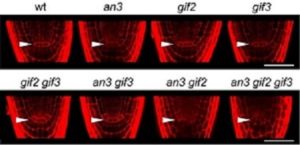 Transcription factor GRFs (GROWTH-REGULATING FACTOR) are specifically expressed in TACs (transit-amplifying cells) and promote rapid cell divisions. Their expression is repressed in stem cells through miR396. In this work, they studied the functions of small cofactors known as GIFs (GRF-INTERACTING FACTORs) for maintaining meristem size and root development. Arabidopsis has three members (GIF1/AN3, GIF2, and GIF3) of this group and their corresponding mutants demonstrate distorted QC (quiescent center) and longer root meristem. As a mechanistic explanation, they have found that AN3/GIF1 binds directly to the promoter region of PLT1 (PLETHORA1) and SCR (SCARECROW) to regulate their expression. Among them, SCR is involved in positioning of the SCN (stem cell niche) and the PLT gradient that determines the root domains. Taken together, this study suggests that GIFs participate in multiple pathways to control QC organization and meristem size. (Summary by Arif Ashraf – @aribidopsis) The Plant Cell 10.1105/tpc.17.00856
Transcription factor GRFs (GROWTH-REGULATING FACTOR) are specifically expressed in TACs (transit-amplifying cells) and promote rapid cell divisions. Their expression is repressed in stem cells through miR396. In this work, they studied the functions of small cofactors known as GIFs (GRF-INTERACTING FACTORs) for maintaining meristem size and root development. Arabidopsis has three members (GIF1/AN3, GIF2, and GIF3) of this group and their corresponding mutants demonstrate distorted QC (quiescent center) and longer root meristem. As a mechanistic explanation, they have found that AN3/GIF1 binds directly to the promoter region of PLT1 (PLETHORA1) and SCR (SCARECROW) to regulate their expression. Among them, SCR is involved in positioning of the SCN (stem cell niche) and the PLT gradient that determines the root domains. Taken together, this study suggests that GIFs participate in multiple pathways to control QC organization and meristem size. (Summary by Arif Ashraf – @aribidopsis) The Plant Cell 10.1105/tpc.17.00856
Photoactivated CRY1 and phyB interact directly with AUX/IAA proteins to inhibit auxin signaling in Arabidopsis (OA)
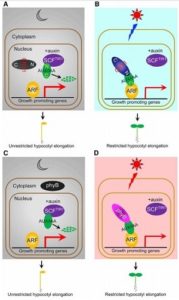 So far we know that light inhibits hypocotyl cell elongation and that the master regulatory plant hormone auxin induces hypocotyl elongation. Light signal depends on cryptochrome (CRY1) and phytochrome (PhyB). Auxin signal follows the traditional TIR1/AFB receptor-mediated degradation of AUX/IAA repressor. In this article, they have figured out the underlying molecular mechanism for hypocotyl growth and convergence point of light and auxin signaling for that purpose. In the absence of light, CRY1 stays in the inactive form and phyB remains in the cytosol, while in the presence of light CRY1 becomes active and phyB moves from cytoplasm to nucleus. In this case, they bind the repressor of auxin signaling pathway, AUX/IAA, and stabilize it. As a result, auxin signaling is stopped and cannot promote hypocotyl elongation. (Summary by Arif Ashraf – @aribidopsis) Molecular Plant 10.1016/j.molp.2017.12.003
So far we know that light inhibits hypocotyl cell elongation and that the master regulatory plant hormone auxin induces hypocotyl elongation. Light signal depends on cryptochrome (CRY1) and phytochrome (PhyB). Auxin signal follows the traditional TIR1/AFB receptor-mediated degradation of AUX/IAA repressor. In this article, they have figured out the underlying molecular mechanism for hypocotyl growth and convergence point of light and auxin signaling for that purpose. In the absence of light, CRY1 stays in the inactive form and phyB remains in the cytosol, while in the presence of light CRY1 becomes active and phyB moves from cytoplasm to nucleus. In this case, they bind the repressor of auxin signaling pathway, AUX/IAA, and stabilize it. As a result, auxin signaling is stopped and cannot promote hypocotyl elongation. (Summary by Arif Ashraf – @aribidopsis) Molecular Plant 10.1016/j.molp.2017.12.003
Trichome branching is regulated by the m6A reader ECT2 in Arabidopsis (OA)
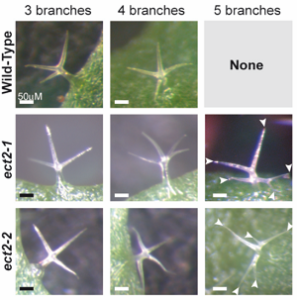 Methylation at position N6 of adenosines (m6A) is the most abundant mRNA chemical modification. It influences gene activity at the post-transcriptional level and is thus important for development. m6A is decoded by reader proteins. While the repertoire of reader proteins has been extensively studied in animals, little is known about its biological relevance and evolutionary history in plants. In this study, Scutenaire et al., provide a comprehensive evolutionary characterization of reader proteins found in the green plant clade. Based on this analysis, they identified and selected ECT2, a putative m6A reader, for further functional analysis. They demonstrate that Arabidopsis ECT2 localizes in the cytoplasm, binds m6A-containing mRNA and likely controls mRNA fate by relocating to stress granules upon heat-stress. They further show that ECT2 m6A reader activity is required for normal trichome branching and regulation of endoreduplication in developing trichomes. Together, this study provides new insights in the molecular function of m6A readers in plants and suggests an extensive role for m6A in regulating physiological and developmental processes in plants. (Summary by Matthias Benoit) Plant Cell 10.1105/tpc.17.00854
Methylation at position N6 of adenosines (m6A) is the most abundant mRNA chemical modification. It influences gene activity at the post-transcriptional level and is thus important for development. m6A is decoded by reader proteins. While the repertoire of reader proteins has been extensively studied in animals, little is known about its biological relevance and evolutionary history in plants. In this study, Scutenaire et al., provide a comprehensive evolutionary characterization of reader proteins found in the green plant clade. Based on this analysis, they identified and selected ECT2, a putative m6A reader, for further functional analysis. They demonstrate that Arabidopsis ECT2 localizes in the cytoplasm, binds m6A-containing mRNA and likely controls mRNA fate by relocating to stress granules upon heat-stress. They further show that ECT2 m6A reader activity is required for normal trichome branching and regulation of endoreduplication in developing trichomes. Together, this study provides new insights in the molecular function of m6A readers in plants and suggests an extensive role for m6A in regulating physiological and developmental processes in plants. (Summary by Matthias Benoit) Plant Cell 10.1105/tpc.17.00854
To the VIKtor goes the Spoils: The Phytophthora infestans Effector Pi17316 Manipulates the Host MAP3K VIK to Promote Disease Susceptibility in Potato (OA)
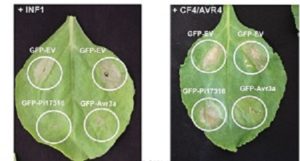 Phytopathogens secrete effector proteins that enter and manipulate plant cells to facilitate microbial growth in planta. This is often achieved by exerting specific activity onto key host proteins to divert host cellular functions towards supporting pathogen growth. In a recently published article in Plant Physiology (2018), Murphy et al. describe the identification of the potato MAP3K VIK (VASCULAR HIGHWAY-INTERACTING KINASE) as the endogenous host target of the Phytophthora infestans (oomycete) RXLR effector protein Pi17316. Virus-induced gene silencing of VIK was shown to impart resistance to Phytophthora, whereas VIK overexpression rendered plants more susceptible to disease. The authors therefore concluded that VIK represents a susceptibility factor that is exploited by P. infestans to facilitate disease progression in potato. (Summary by Philip Carella) Plant Phys. 10.1104/pp.18.00028
Phytopathogens secrete effector proteins that enter and manipulate plant cells to facilitate microbial growth in planta. This is often achieved by exerting specific activity onto key host proteins to divert host cellular functions towards supporting pathogen growth. In a recently published article in Plant Physiology (2018), Murphy et al. describe the identification of the potato MAP3K VIK (VASCULAR HIGHWAY-INTERACTING KINASE) as the endogenous host target of the Phytophthora infestans (oomycete) RXLR effector protein Pi17316. Virus-induced gene silencing of VIK was shown to impart resistance to Phytophthora, whereas VIK overexpression rendered plants more susceptible to disease. The authors therefore concluded that VIK represents a susceptibility factor that is exploited by P. infestans to facilitate disease progression in potato. (Summary by Philip Carella) Plant Phys. 10.1104/pp.18.00028
RH8-PP2CA interaction in ABA signaling ($)
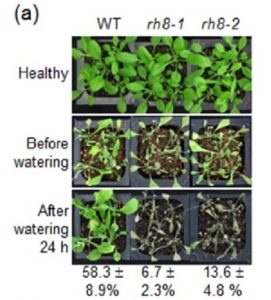 It is well understood that abscisic acid (ABA) inhibits PPC2A phosphatase activity, which subsequently relieves phosphate-induced inhibition of a kinase interacting partner. This pathway composes the ‘core’ ABA signaling pathway, activating process involved in the ABA response such as stomatal closure to preserve water loss. Baek et al. identified an additional player in this core ABA pathway via yeast two-hybrid screening for PP2CA interactors: the DEAD-box RNA helicase, RH8. Interestingly, while the above pathway occurs in the cytoplasm, RH8 was found to interact with PP2CA in the nucleus. Furthermore, rh8 mutants are hyposensitive to ABA and display reduced stomatal closure while rh8 pp2ca double mutants display the opposite phenotype: ABA hypersensitive and drought tolerance. This paper adds to the core ABA signaling pathway, introducing RH8 as an inhibitor of PP2CA phosphatase activity (Summary by Alecia Biel) Plant, Cell, & Enviorn. 10.1111/pce.13200
It is well understood that abscisic acid (ABA) inhibits PPC2A phosphatase activity, which subsequently relieves phosphate-induced inhibition of a kinase interacting partner. This pathway composes the ‘core’ ABA signaling pathway, activating process involved in the ABA response such as stomatal closure to preserve water loss. Baek et al. identified an additional player in this core ABA pathway via yeast two-hybrid screening for PP2CA interactors: the DEAD-box RNA helicase, RH8. Interestingly, while the above pathway occurs in the cytoplasm, RH8 was found to interact with PP2CA in the nucleus. Furthermore, rh8 mutants are hyposensitive to ABA and display reduced stomatal closure while rh8 pp2ca double mutants display the opposite phenotype: ABA hypersensitive and drought tolerance. This paper adds to the core ABA signaling pathway, introducing RH8 as an inhibitor of PP2CA phosphatase activity (Summary by Alecia Biel) Plant, Cell, & Enviorn. 10.1111/pce.13200
SIAMESE-RELATED1 (SMR1) has roles in leaf growth repression under drought (OA)
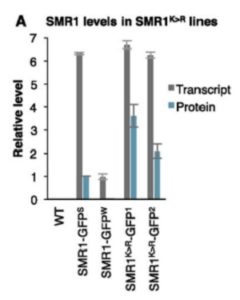 The cell cycle of plants is regulated by signals that integrate endogenous and environmental cues to allow for adaptation to varying conditions. When a plant is under drought stress, cell division in young leaves is stopped by an active mechanism to conserve resources. Cyclin-dependent kinase-inhibitory proteins (CKIs) have been studied in relation to cell cycle regulation but little is known about their function under stressful conditions. Dubois and colleagues use expression studies, mutant analysis and protein studies to examine the role of the Arabidopsis CKI gene SIAMESE-RELATED1 (SMR1) under drought stress. In young leaves, SMR1 expression is induced by drought and SMR1 inhibits cell division and modifies meristem activity. SMR1 is a short-lived protein that is degraded by the 26S proteasome after being ubiquitinated. The over-expression of a more stable SMR1 protein in Arabidopsis leads to a stronger phenotype (i.e. greater growth inhibition under drought stress). The SMR1 protein may act as a negative regulator of cell division of leaves and roots. (Summary by Julia Miller) Plant Phys. 10.1104/pp.17.01712
The cell cycle of plants is regulated by signals that integrate endogenous and environmental cues to allow for adaptation to varying conditions. When a plant is under drought stress, cell division in young leaves is stopped by an active mechanism to conserve resources. Cyclin-dependent kinase-inhibitory proteins (CKIs) have been studied in relation to cell cycle regulation but little is known about their function under stressful conditions. Dubois and colleagues use expression studies, mutant analysis and protein studies to examine the role of the Arabidopsis CKI gene SIAMESE-RELATED1 (SMR1) under drought stress. In young leaves, SMR1 expression is induced by drought and SMR1 inhibits cell division and modifies meristem activity. SMR1 is a short-lived protein that is degraded by the 26S proteasome after being ubiquitinated. The over-expression of a more stable SMR1 protein in Arabidopsis leads to a stronger phenotype (i.e. greater growth inhibition under drought stress). The SMR1 protein may act as a negative regulator of cell division of leaves and roots. (Summary by Julia Miller) Plant Phys. 10.1104/pp.17.01712
Identification and characterization of wheat stem rust resistance gene Sr21 effective against the Ug99 race group at high temperature (OA)
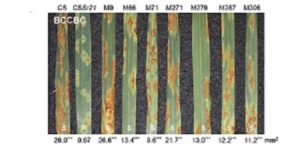 Stem rust is a fungal disease of wheat caused by Puccinia graminis f. sp. tritici (Pgt). The Ug99 race group of the fungus has evolved the ability to overcome most stem rust (Sr) resistance genes. Previously, Sr21, an Sr gene that confers partial resistance to Ug99, was found in diploid wheat. Chen et al. showed that Sr21 corresponds to the NLR gene, CNL1, which encodes a nucleotide-binding leucine-rich repeat (NLR) protein. Introduction of two or more copies of Sr21 into hexaploid wheat led to partial Ug99 resistance. Interestingly, resistance conferred by CNL1 is increased at higher temperatures. CNL1 transcripts and transcripts of key pathogenesis-related genes are also elevated at higher temperatures. (Summary by Mary Williams) PLOS Genet. 10.1371/journal.pgen.1007287
Stem rust is a fungal disease of wheat caused by Puccinia graminis f. sp. tritici (Pgt). The Ug99 race group of the fungus has evolved the ability to overcome most stem rust (Sr) resistance genes. Previously, Sr21, an Sr gene that confers partial resistance to Ug99, was found in diploid wheat. Chen et al. showed that Sr21 corresponds to the NLR gene, CNL1, which encodes a nucleotide-binding leucine-rich repeat (NLR) protein. Introduction of two or more copies of Sr21 into hexaploid wheat led to partial Ug99 resistance. Interestingly, resistance conferred by CNL1 is increased at higher temperatures. CNL1 transcripts and transcripts of key pathogenesis-related genes are also elevated at higher temperatures. (Summary by Mary Williams) PLOS Genet. 10.1371/journal.pgen.1007287
Rapid generation of a transgene-free powdery mildew resistant tomato by genome deletion (OA)
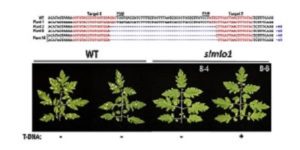 Using a traditional breeding approach, introducing a single gene into a desirable cultivar requires repeated backcrossing. This lengthy process can be circumvented through genetic engineering (making transgenic plants), but consumer concerns and extensive, expensive regulatory hurdles have stifled many transgenic projects. New genome editing methods are likely to have fewer regulatory obstacles, so are a promising alternative for crop improvement. Nekrasov et al. have used a gene-editing approach to delete a gene (Mlo) that makes tomato plants susceptible to the fungus that causes powdery mildew. They produced transgene-free mildew-resistant varieties (with no off-site alterations) in less than a year. (Summary by Mary Williams) Sci. Rep. 10.1038/s41598-017-00578-x
Using a traditional breeding approach, introducing a single gene into a desirable cultivar requires repeated backcrossing. This lengthy process can be circumvented through genetic engineering (making transgenic plants), but consumer concerns and extensive, expensive regulatory hurdles have stifled many transgenic projects. New genome editing methods are likely to have fewer regulatory obstacles, so are a promising alternative for crop improvement. Nekrasov et al. have used a gene-editing approach to delete a gene (Mlo) that makes tomato plants susceptible to the fungus that causes powdery mildew. They produced transgene-free mildew-resistant varieties (with no off-site alterations) in less than a year. (Summary by Mary Williams) Sci. Rep. 10.1038/s41598-017-00578-x
A Small Peptide Signal Regulates Systemic Responses to Plant Water Status ($)
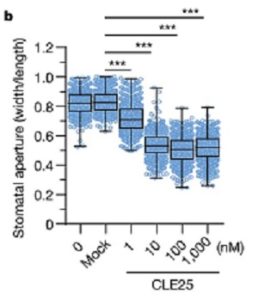 Plant organs perceive their immediate environment and communicate over both short and long distances to regulate the physiology of the affected organ as well as organs distal to the perceived stress. To accomplish this, plants utilize an impressive array of signalling molecules which range from small chemical signatures to macromolecules such as proteins and RNA. In a recent Letter to Nature, Takahashi et al. demonstrate that systemic responses to water deficit are regulated by the long distance movement of the small signalling peptide CLE25 in Arabidopsis thaliana. The authors demonstrate the accumulation and long-distance movement of the CLE25 peptide hormone from roots to shoots in drought stressed plants, where CLE25 was shown to modulate stomatal aperture to conserve water. This activity was dependent on the presence functional BAM (BARELY ANY MERISTEM) receptor proteins, which argues for the presence of a systemic CLE25-BAM signalling module that is essential for aboveground responses to dehydration. (Summary by Philip Carella) Nature 10.1038/s41586-018-0009-2
Plant organs perceive their immediate environment and communicate over both short and long distances to regulate the physiology of the affected organ as well as organs distal to the perceived stress. To accomplish this, plants utilize an impressive array of signalling molecules which range from small chemical signatures to macromolecules such as proteins and RNA. In a recent Letter to Nature, Takahashi et al. demonstrate that systemic responses to water deficit are regulated by the long distance movement of the small signalling peptide CLE25 in Arabidopsis thaliana. The authors demonstrate the accumulation and long-distance movement of the CLE25 peptide hormone from roots to shoots in drought stressed plants, where CLE25 was shown to modulate stomatal aperture to conserve water. This activity was dependent on the presence functional BAM (BARELY ANY MERISTEM) receptor proteins, which argues for the presence of a systemic CLE25-BAM signalling module that is essential for aboveground responses to dehydration. (Summary by Philip Carella) Nature 10.1038/s41586-018-0009-2
The “PhenoBox”, a flexible, automated, open-source plant phenotyping data solution (OA)
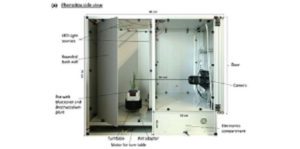 High-throughput plant phenotyping systems are an excellent tool for analyzing large plant populations, providing better understanding of plant growth, productivity and performance under stress conditions. Unfortunately, high-throughput platforms are also high on costs and limited in their adaptability for specific questions, limiting the use by the researchers. Czedik-Eysenberg et al. presents a PhenoBox/PhenoPipeline, a scalable and flexible alternative to commercial high-throughput phenotyping platforms. The system is able to collect the visual data, recognize specific plans based on the QR code, and pre-process the images before sending them to the server for further analysis by the PhenoPipeline. The phenotyping system is set to perform all the analysis steps, from image capture and segmentation all the way to statistical analysis of sample groups. Most importantly, the code for operating the PhenoBox, PhenoPipeline and the documents on how to set up your own phenotyping platform are publically available, and can be adjusted to perform research-driven phenotyping, rather than being restricted by the commercial systems. (Summary by Magdalena Julkowska) New Phyt. 10.1111/nph.15129
High-throughput plant phenotyping systems are an excellent tool for analyzing large plant populations, providing better understanding of plant growth, productivity and performance under stress conditions. Unfortunately, high-throughput platforms are also high on costs and limited in their adaptability for specific questions, limiting the use by the researchers. Czedik-Eysenberg et al. presents a PhenoBox/PhenoPipeline, a scalable and flexible alternative to commercial high-throughput phenotyping platforms. The system is able to collect the visual data, recognize specific plans based on the QR code, and pre-process the images before sending them to the server for further analysis by the PhenoPipeline. The phenotyping system is set to perform all the analysis steps, from image capture and segmentation all the way to statistical analysis of sample groups. Most importantly, the code for operating the PhenoBox, PhenoPipeline and the documents on how to set up your own phenotyping platform are publically available, and can be adjusted to perform research-driven phenotyping, rather than being restricted by the commercial systems. (Summary by Magdalena Julkowska) New Phyt. 10.1111/nph.15129
Phytophthora palmivora establishes tissue-specific intracellular infection structures in the earliest divergent land plant lineage (OA)
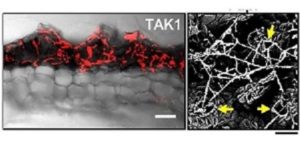 Surprisingly little is known about the pathogens of liverworts. Carella et al. explored the interaction between the broad-host range pathogenic oomycete Phytophthora palmivora and the model liverwort Marchantia polymorpha. They found that the pathogen enters the host tissues and proliferates in intercellular air chambers between photosynthetic cells, and also forms intracellular hyphal structures and expresses effector genes. This study revealed similarities as well as differences between liverwort and vascular plant responses to the pathogen. The authors point out that the branched intracellular hyphae that form could be mistaken for symbiotic structures, and recommend care when interpreting symbiotic-like structures in fossil plants. (Summary by Mary Williams) PNAS 10.1073/pnas.1717900115. (You can watch a video summary of this work here). Carella and Schonack have also written about the interactions between bryophyte hosts and pathogenic or symbiotic microbes in a nice review article in Plant and Cell Physiology 10.1093/pcp/pcx182.
Surprisingly little is known about the pathogens of liverworts. Carella et al. explored the interaction between the broad-host range pathogenic oomycete Phytophthora palmivora and the model liverwort Marchantia polymorpha. They found that the pathogen enters the host tissues and proliferates in intercellular air chambers between photosynthetic cells, and also forms intracellular hyphal structures and expresses effector genes. This study revealed similarities as well as differences between liverwort and vascular plant responses to the pathogen. The authors point out that the branched intracellular hyphae that form could be mistaken for symbiotic structures, and recommend care when interpreting symbiotic-like structures in fossil plants. (Summary by Mary Williams) PNAS 10.1073/pnas.1717900115. (You can watch a video summary of this work here). Carella and Schonack have also written about the interactions between bryophyte hosts and pathogenic or symbiotic microbes in a nice review article in Plant and Cell Physiology 10.1093/pcp/pcx182.
Similar but Different: A Functionally Conserved of COI1 Receptor Recognizes Jasmonate Precursors in the Liverwort Marchantia polymorpha ($)
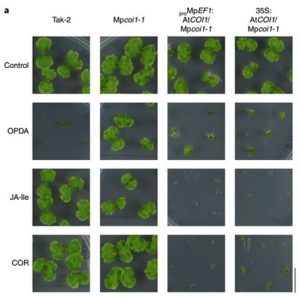 Land plants evolved from freshwater charophyte algae over 450 million years ago and have since diverged into the multitude of plant lineages observed today. The extent to which prominent plant hormones and cognate receptor proteins, which play essential roles in evolutionarily young angiosperms, are conserved across the green plant lineage is currently unknown. In a keystone paper published in Nature Chemical Biology (2018), Monte et al. demonstrate that the COI1 receptor protein is functionally conserved in the early land plant model system Marchantia polymorpha (liverwort), which specifically recognizes the jasmonate precursor molecule dn-OPDA rather than JA-isoleucine. Strikingly, the authors demonstrate that a single amino acid change in the COI1 receptor determines ligand specificity, such that targeted mutations resembling angiosperm COI1 homologs affords sensitivity to JA-ile in liverworts. This study highlights the usefulness of early land plant model systems in revealing essential plant traits and begins to unravel receptor-ligand co-evolution in the jasmonate signalling pathway across land plants. (Summary by Philip Carella) Nat. Chem. Bio. 10.1038/s41589-018-0033-4
Land plants evolved from freshwater charophyte algae over 450 million years ago and have since diverged into the multitude of plant lineages observed today. The extent to which prominent plant hormones and cognate receptor proteins, which play essential roles in evolutionarily young angiosperms, are conserved across the green plant lineage is currently unknown. In a keystone paper published in Nature Chemical Biology (2018), Monte et al. demonstrate that the COI1 receptor protein is functionally conserved in the early land plant model system Marchantia polymorpha (liverwort), which specifically recognizes the jasmonate precursor molecule dn-OPDA rather than JA-isoleucine. Strikingly, the authors demonstrate that a single amino acid change in the COI1 receptor determines ligand specificity, such that targeted mutations resembling angiosperm COI1 homologs affords sensitivity to JA-ile in liverworts. This study highlights the usefulness of early land plant model systems in revealing essential plant traits and begins to unravel receptor-ligand co-evolution in the jasmonate signalling pathway across land plants. (Summary by Philip Carella) Nat. Chem. Bio. 10.1038/s41589-018-0033-4



